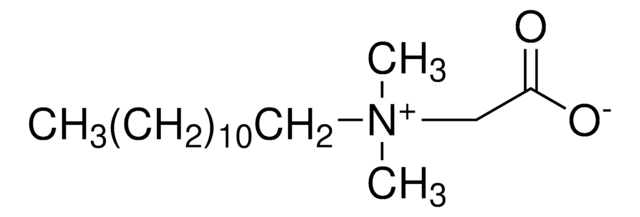Key Documents
H6883
3-(N,N-Dimethylpalmitylammonio)propanesulfonate
≥98% (TLC)
Synonim(y):
3-(N,N-Dimethylhexadecylammonio)propanesulfonate, 3-(Hexadecyldimethylammonio)propanesulfonate, 3-(Palmityldimethylammonio)propanesulfonate, Palmityl sulfobetaine, SB3-16
About This Item
Polecane produkty
opis
zwitterionic
Próba
≥98% (TLC)
masa cząsteczkowa
micellar avg mol wt 60,700
liczba agregacji
155
metody
electrophoresis: suitable
mass spectrometry (MS): suitable
thin layer chromatography (TLC): suitable
przewodność
≤10 μmho per cm at 24 °C (0.05 M aqueous solution)
CMC
0.01-0.06 mM (20-25°C)
Zastosowanie
cell analysis
ciąg SMILES
CCCCCCCCCCCCCCCC[N+](C)(C)CCCS([O-])(=O)=O
InChI
1S/C21H45NO3S/c1-4-5-6-7-8-9-10-11-12-13-14-15-16-17-19-22(2,3)20-18-21-26(23,24)25/h4-21H2,1-3H3
Klucz InChI
TUBRCQBRKJXJEA-UHFFFAOYSA-N
Szukasz podobnych produktów? Odwiedź Przewodnik dotyczący porównywania produktów
Opis ogólny
Zastosowanie
Kod klasy składowania
11 - Combustible Solids
Klasa zagrożenia wodnego (WGK)
WGK 3
Temperatura zapłonu (°F)
230.0 °F - closed cup
Temperatura zapłonu (°C)
110 °C - closed cup
Środki ochrony indywidualnej
dust mask type N95 (US), Eyeshields, Gloves
Certyfikaty analizy (CoA)
Poszukaj Certyfikaty analizy (CoA), wpisując numer partii/serii produktów. Numery serii i partii można znaleźć na etykiecie produktu po słowach „seria” lub „partia”.
Masz już ten produkt?
Dokumenty związane z niedawno zakupionymi produktami zostały zamieszczone w Bibliotece dokumentów.
Klienci oglądali również te produkty
Nasz zespół naukowców ma doświadczenie we wszystkich obszarach badań, w tym w naukach przyrodniczych, materiałoznawstwie, syntezie chemicznej, chromatografii, analityce i wielu innych dziedzinach.
Skontaktuj się z zespołem ds. pomocy technicznej



![[2-(Methacryloyloxy)ethyl]dimethyl-(3-sulfopropyl)ammonium hydroxide 95%](/deepweb/assets/sigmaaldrich/product/structures/217/219/73c91e1c-0ee4-4b3d-bead-a6dc3d09d1da/640/73c91e1c-0ee4-4b3d-bead-a6dc3d09d1da.png)




